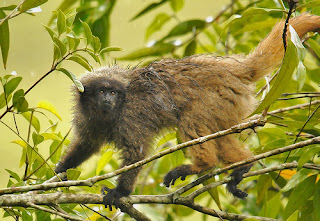Coimbra Filho's titi
The Coimbra - titi ( Callicebus coimbrai ) is a primate of the species of titi monkeys within the family of Sakiaffen ( Pitheciidae ). It is named in honor of the Brazilian zoologists Adelmar Faria Coimbra - Filho and was described in 1999.
Features
Coimbra - titi monkeys are like all titi monkeys relatively small primate with a dense fur and a long, bushy tail, which can not be used as a prehensile tail. Their fur is gray or yellow-gray, on the back there are some implied dark horizontal stripes. The hands and feet are black and the tail is colored bright orange. The head is small and round, at the end there is a black horizontal stripes, which merges into the also black colored ear tufts.
Distribution and habitat
Coimbra - titi monkeys live in southeastern Brazil, their range includes the coastal strip of Sergipe and the Northeast of Bahia. Their habitat is forests.
Way of life
Little is known about the life of the Coimbra titi monkeys, probably agrees with that of the other titi monkeys match. Titi monkeys are diurnal and usually stay up in the trees. They move away either quadruped or jumping. They live in family groups, both partners often remain for a lifetime together. These groups inhabiting a fixed territory that is communicated to other animals by morning duet songs. Their diet consists mainly of fruits, to a lesser extent they also eat leaves and sometimes insects. The fathers are intensively involved in the breeding season, they carry the child and give it to the mother only for suckling.
Endangering
The Atlantic coastal forests of Brazil have been destroyed by conversion into agricultural areas or residential areas to a large extent, by the range of the Coimbra - titi monkeys was greatly reduced and fragmented. It now comprises a total of 150 km ², the total population is estimated to be around 500 to 1000 animals. The IUCN lists the species as " critically endangered " ( endangered ).










